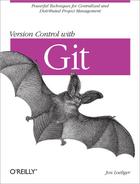Colophon
The animal on the cover of Version Control with Git is a long-eared bat. It is a fairly large bat that is common and widespread throughout Great Britain and Ireland. It can also be found in Japan. Often seen in colonies of 50 to a 100 or more, it lives in open woodlands, as well as parks and gardens and in spaces under houses and church roofs. It also hibernates in caves, where it is more solitary in habit.
The long-eared bat is a medium-size bat with a broad wingspan of about 25 cm. Its ears are very long and have a very distinctive fold—their inner edges meet each other on the top of the head, and their outer edges end just behind the angle of the mouth. When the bat sleeps, it folds its ears under its wings. During flight, the ears are pointing forward. Its fur is long, fluffy, and silky, extending a short way onto the surface of its wings. It is dusky brown in color on top and light or dirty brown in color below. Juveniles are pale grey, lacking the brown tinges of the adults. Their diet consists of flies, moths, and beetles. It glides among foliage, frequently hovering to scour for insects. When traveling to another tree, its flight is swift, strong, and close to the ground.
Long-eared bats breed in autumn and spring. Pregnant females form nursery colonies of 100 or more in early summer, and the single young or twins are born in June and July.
Bats are the only true flying mammals. Contrary to popular misconception, they are not blind—many can actually see very well. All British bats use echolocation to orient themselves at night; they emit bursts of sound that are of such high frequencies they are beyond the human range of hearing and are therefore called “ultrasound.” The bats then listen to and interpret the echoes bounced back from objects around them (including prey), which allows them to build a “sound-picture” of their surroundings.
Like all bats, this species is vulnerable to a number of threats, including the loss of roost sites, as hollow trees are often cut down if thought unsafe. Pesticide use has devastating effects, causing severe declines in insect abundance and contaminating food with potentially fatal toxins. Insecticides applied to timbers inside buildings where roosts occur are a particular danger—the initial treatment can wipe out whole colonies (spraying timber where bats are roosting is now illegal), but the effects of these chemicals can be lethal to bats for up to 20 years. In Britain, under the Wildlife and Countryside Act, it is illegal to intentionally kill, injure, take, or sell a bat; to possess a live bat or part of a bat; and to intentionally, recklessly damage, obstruct, or destroy access to bat roosts. Under the conservation regulations, it is an offense to damage or destroy breeding sites or resting places. Offenders can be charged up to 5,000 pounds per bat affected and be sentenced to six months imprisonment.
The cover image is from Lydekker’s. The cover font is Adobe ITC Garamond. The text font is Linotype Birka; the heading font is Adobe Myriad Condensed; and the code font is LucasFont’s TheSansMonoCondensed.
